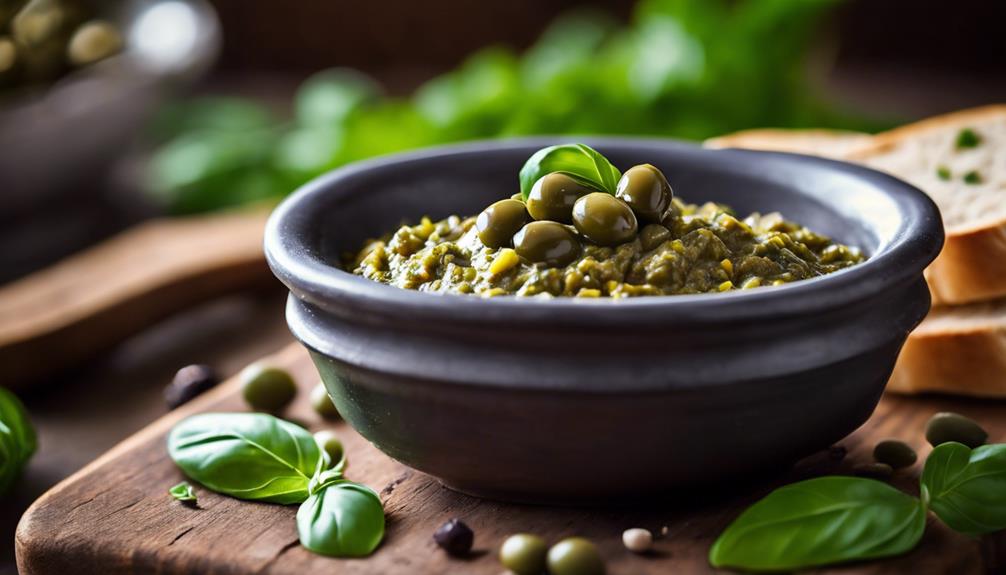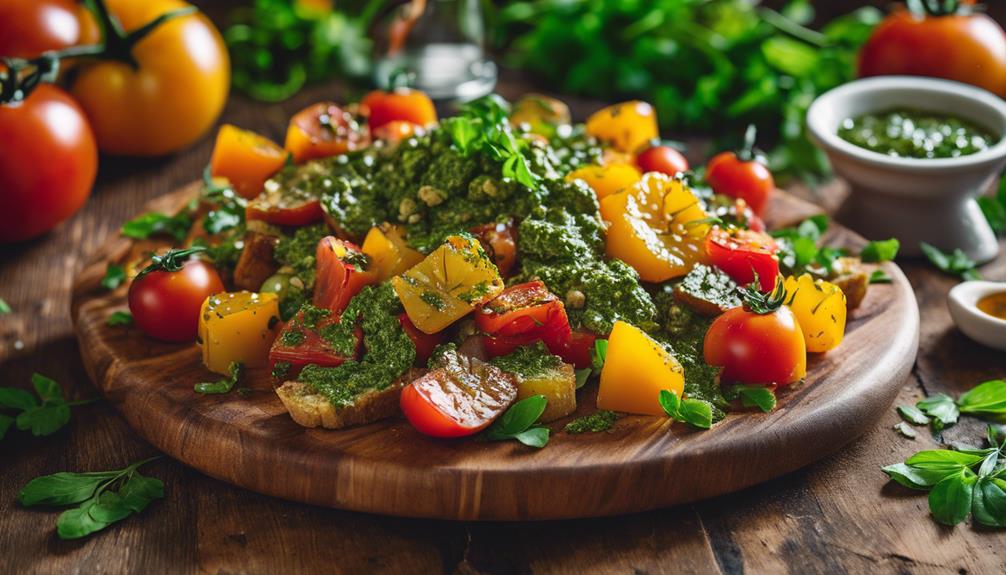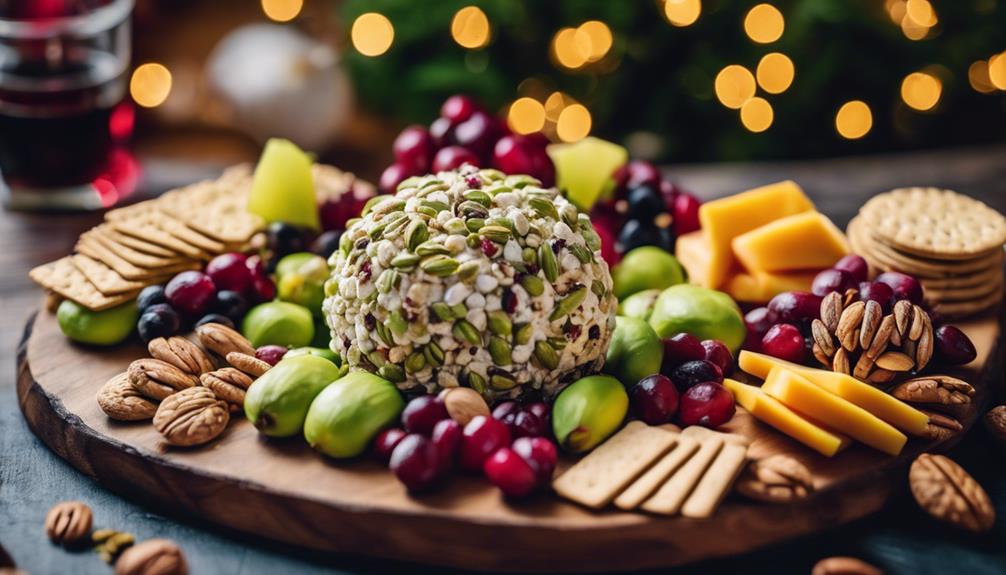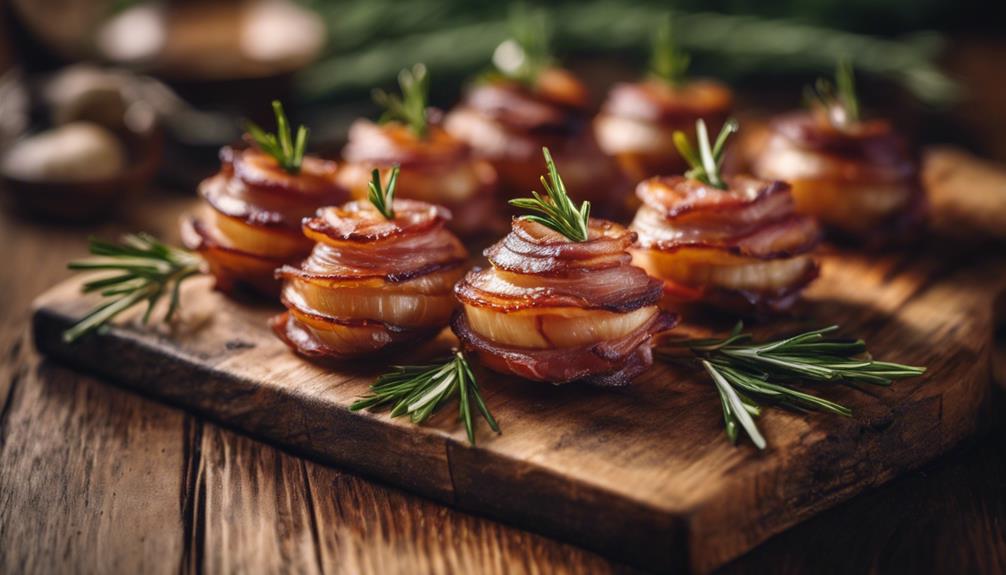Green Olive Tapenade is a delicious spread made from green olives, capers, olive oil, and seasonings, offering a tangy and savory flavor that can be used in various culinary dishes. By adding herbs, lemon juice, or nuts, you can customize the taste to your liking. Use high-quality olives such as Castelvetrano or Kalamata for a well-balanced mix. Store in the refrigerator for up to 7 days or freeze for 3 months in a suitable container. Enjoy it with crusty bread, mix it into pasta dishes, or serve alongside grilled meats for a memorable dining experience. Explore expert tips, flavor variations, and more to fully appreciate this versatile spread.
Key Takeaways
- Green Olive Tapenade is a tangy and savory spread perfect for dips, spreads, or meat toppings.
- Ingredients like green olives, capers, and olive oil create a harmonious and flavorful blend.
- Customizable with herbs, lemon juice, or nuts for personalized taste preferences.
- Versatile for various occasions and pairs well with bread, crackers, vegetables, meats, and seafood.
- Store in the refrigerator for up to 7 days or freeze for up to 3 months in a freezer-safe container.
Recipe Overview
For an introduction to making green olive tapenade, let's explore the recipe overview. The Green Olive Tapenade Recipe is a delectable spread crafted from olives, capers, olive oil, and a blend of seasonings.
This versatile food item can be utilized as a dip, spread on sandwiches, or even as a flavorful topping for grilled meats. The tangy and savory taste profile of green olive tapenade makes it a perfect choice for appetizers and snacks.
Creating your own green olive tapenade allows you the freedom to customize it according to your preferences. Whether you wish to enhance the flavors with herbs, add a hint of freshness with lemon juice, or introduce a bit of crunch with nuts, the possibilities are endless.
Key Ingredients
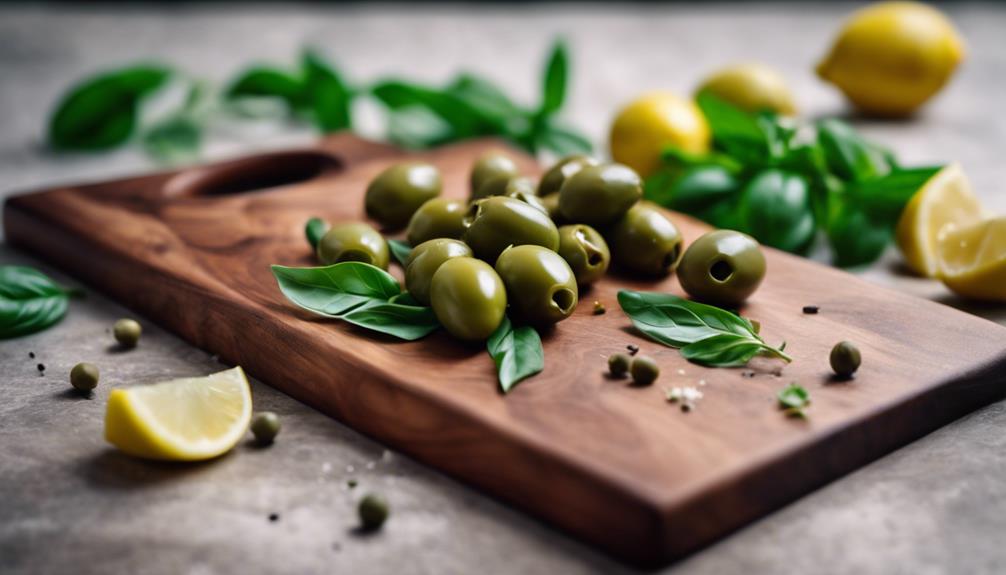
When creating green olive tapenade, it's essential to take into account the key ingredients that will elevate its flavors.
The selection of flavorful green olives like Castelvetrano or Kalamata, along with the addition of tangy capers, plays a significant role in enhancing the taste profile of the dish.
Understanding how these ingredients work together can help you achieve a well-balanced and delicious tapenade.
Flavorful Olive Selection
Selecting the right green olives, like Castelvetrano, is crucial for achieving the desired flavor profile in your green olive tapenade. When choosing olives for your tapenade, consider the following:
- Green Olives Variety: Opt for Castelvetrano olives, known for their vibrant green hue, buttery texture, and mild flavor, which are perfect for creating a smooth and delicious tapenade.
- Quality Matters: Guarantee the olives are of high quality to enhance the overall taste of your tapenade. Look for olives that are plump, firm, and fresh to ensure a flavorful outcome.
- Balanced Flavor: The right balance between the olives' mild and buttery notes and the sharpness of capers will create a harmonious blend that's both savory and tangy, elevating your tapenade to a delectable spread for various culinary creations.
Tangy Preparation Technique
Consider incorporating key ingredients like capers, garlic, and olive oil to infuse your green olive tapenade with a tangy and savory flavor profile. These ingredients work together harmoniously to create a delicious spread that is perfect for various dishes and occasions. Below is a table outlining the key ingredients for preparing a tangy green olive tapenade:
| Ingredients | Description | Benefits |
|---|---|---|
| Green Olives | Briny and tangy | Provides the base flavor |
| Capers | Salty and tangy | Adds a punch of flavor |
| Garlic | Pungent | Enhances savory notes |
| Olive Oil | Rich and fruity | Helps bind ingredients together |
Step-by-Step Instructions
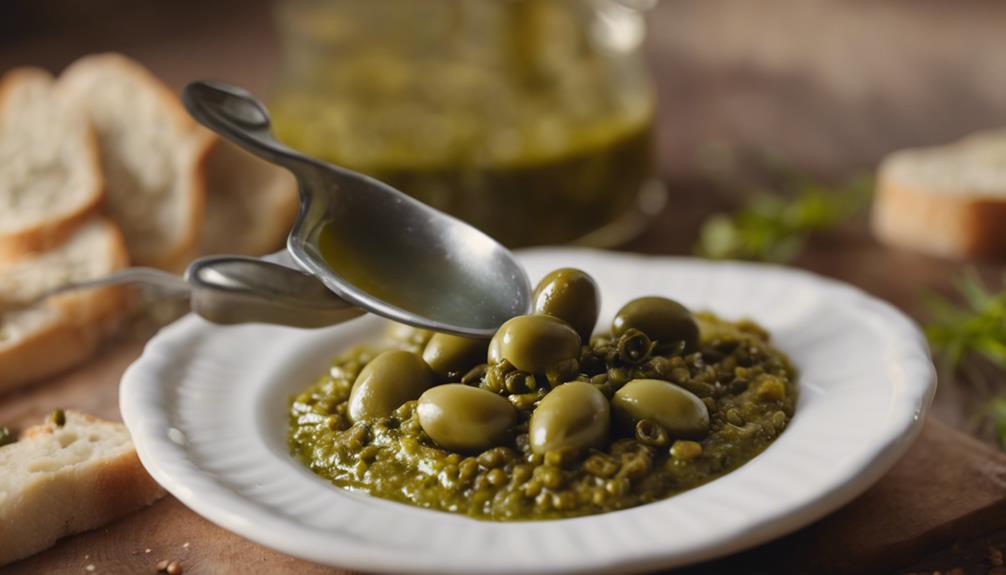
Begin by gathering all the necessary ingredients and equipment for making green olive tapenade. Here's a simple guide to help you make this tangy Olive Spread:
- Prepare Ingredients:
Collect green olives, capers, olive oil, lemon juice, garlic, and seasoning.
- Blend Ingredients:
Combine the green olives, capers, lemon juice, and garlic in a food processor. Slowly add olive oil until the mixture reaches your desired consistency.
- Adjust Seasoning:
Taste the tapenade and adjust the seasoning as needed. You can add more lemon juice for acidity or salt for extra flavor.
Following these steps will help you create a flavorful and versatile green olive tapenade that can elevate your snacking experience or enhance the taste of various dishes.
Enjoy the process of blending these ingredients to achieve the perfect balance of tangy and savory flavors in your tapenade.
Flavor Variations
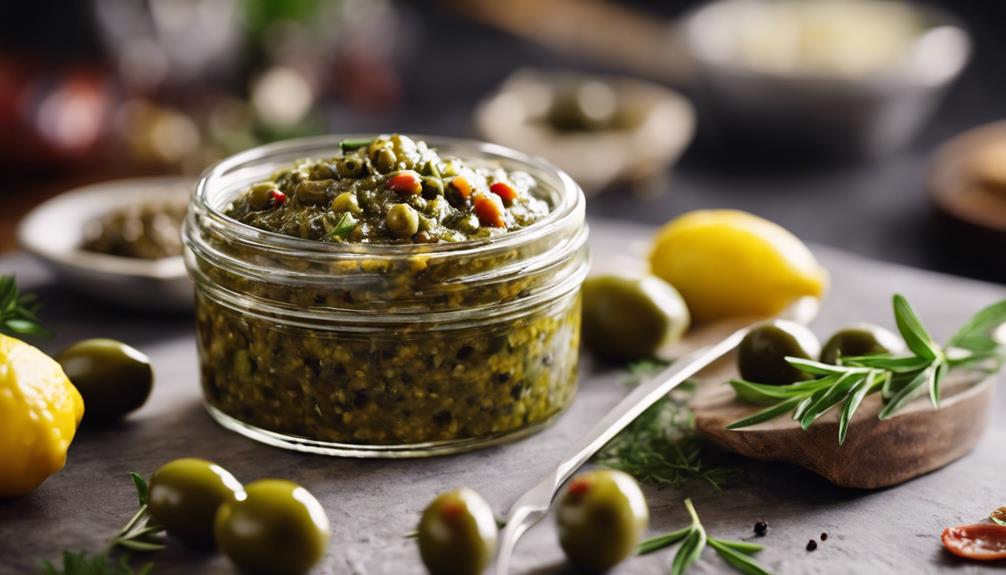
When it comes to flavor variations in green olive tapenade, you can explore unique ingredient combinations to create a personalized taste experience.
Seasonal flavor options allow you to guarantee the tapenade to match the time of year or specific occasions.
Customization for preferences guarantees that your green olive tapenade caters to your individual tastes and culinary preferences.
Unique Ingredient Combinations
Explore exciting flavor variations for your green olive tapenade by incorporating unique ingredient combinations like sun-dried tomatoes, roasted red peppers, spicy elements, fresh herbs, and toasted nuts. These additions can elevate the taste profile of your tapenade, offering a blend of sweet, smoky, spicy, and aromatic notes that will tantalize your taste buds.
Here are some suggestions to enhance your tapenade:
- Sun-Dried Tomatoes: Add a sweet and tangy twist to your tapenade by mixing in sun-dried tomatoes, which will introduce a burst of rich flavor to the spread.
- Roasted Red Peppers: For a smoky and slightly sweet undertone, consider incorporating roasted red peppers into your tapenade mixture, providing a depth of flavor that complements the green olives.
- Spicy Elements: If you enjoy a bit of heat, experiment with red pepper flakes or diced jalapeños to infuse your tapenade with a spicy kick, balancing the overall taste profile with a touch of heat.
Seasonal Flavor Options
Enhance the seasonal appeal of your green olive tapenade by incorporating fresh herbs such as basil or mint for a burst of invigorating flavor. These herbs not only add a delightful fragrance but also infuse the tapenade with a revitalizing taste that complements the brininess of the olives.
For a sweet and tangy contrast, consider adding sun-dried tomatoes to your tapenade mixture. The rich intensity of the sun-dried tomatoes can elevate the overall flavor profile of the spread.
If you crave a bit of heat, incorporating red pepper flakes or a dash of hot sauce can provide that spicy kick you desire. Additionally, experimenting with different citrus fruits like orange or grapefruit can introduce a unique twist to the traditional lemon juice in tapenade, offering a bright and zesty flavor dimension.
These seasonal flavor options allow you to customize your green olive tapenade according to your taste preferences and the ingredients available during different times of the year.
Customization for Preferences
To tailor your green olive tapenade to your liking, simply adjust the types and ratios of olives used in the recipe. Here are a few ways you can customize your tapenade to suit your preferences:
- Incorporate Different Herbs: Experiment with dried herbs like parsley, basil, or oregano to enhance the flavor profile of your tapenade. These herbs can add depth and complexity to the spread, giving it a more invigorating zing.
- Play with Citrus: For a tangier kick, consider increasing the amount of lemon juice or zest in your tapenade recipe. The citrusy brightness can elevate the overall taste and provide a revitalizing zing to each bite.
- Spice it Up: Add a touch of black pepper or experiment with crushed red pepper or cayenne to give your tapenade a spicy twist. These spices can add a kick that complements the savory and tangy flavors of the green olives, creating a well-rounded taste experience.
Serving Suggestions
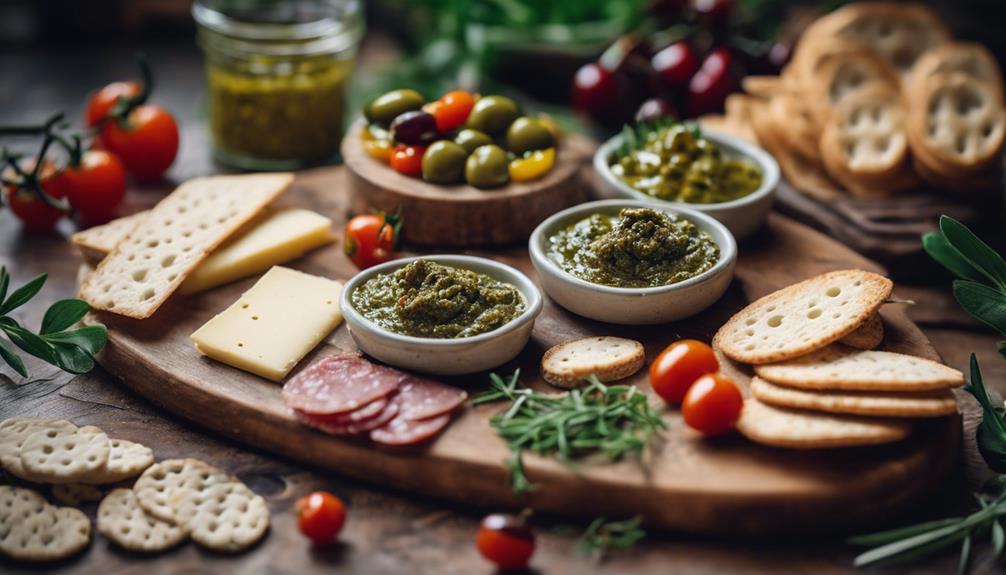
Try spreading green olive tapenade on crostini or crackers for a quick and delicious appetizer option. This flavorful paste made from green olives is a versatile spread that can elevate your appetizer game. Consider serving it alongside a selection of cheeses, fruits, and charcuterie on a party platter for an elegant touch.
The tangy and savory notes of the tapenade complement a variety of ingredients, making it a perfect addition to your culinary creations.
For a main course, use green olive tapenade as a topping for grilled fish, chicken, or vegetables to infuse Mediterranean flavors into your dishes. You can also mix it into pasta dishes or salads to provide an extra layer of complexity.
Get creative by incorporating tapenade as a marinade or sauce for roasted meats, or simply use it to enhance the flavor profile of sandwiches and wraps. With its bold taste and versatility, green olive tapenade is sure to impress your guests and elevate your meals to the next level.
Storage Tips

For peak freshness, make sure you store green olive tapenade in an airtight container in the refrigerator. Here are some essential storage tips to make certain your tapenade stays delicious:
- Refrigeration: Store your green olive tapenade in the refrigerator to maintain its flavors and texture. The cold temperature helps preserve the freshness of the ingredients.
- Shelf Life: Green olive tapenade can be kept for up to 7 days in the refrigerator. It's important to pay attention to the expiration date to enjoy it at its best.
- Freezing Option: If you need to store your tapenade for a longer period, freezing is an option. Green olive tapenade can be frozen for up to 3 months. Be sure you use a freezer-safe container to maintain its quality.
Pairing Ideas
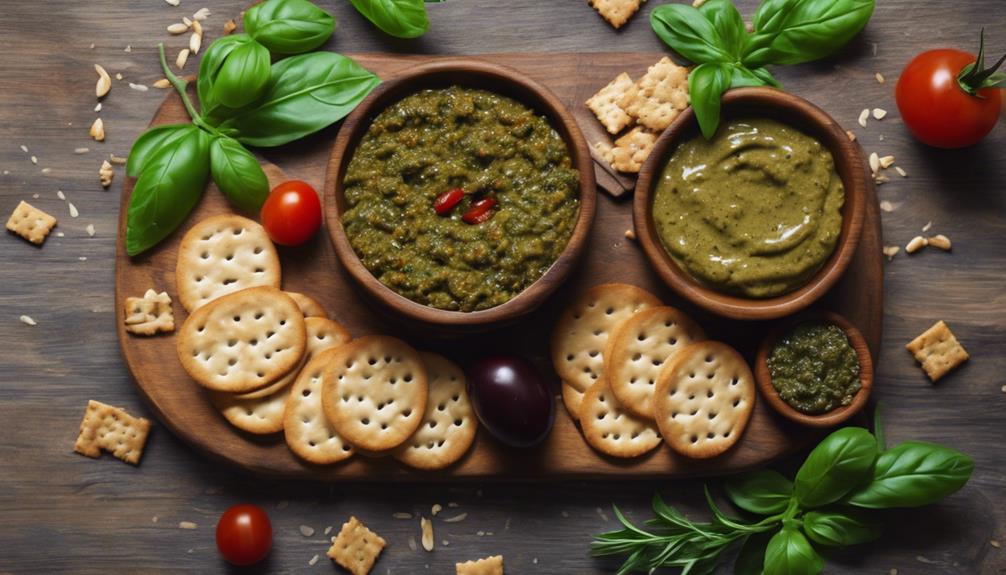
Enhance your culinary experience by combining green olive tapenade with a variety of delicious accompaniments. Green olive tapenade pairs exceptionally well with crusty bread, providing a perfect base for the tangy and savory flavors to shine through.
Additionally, consider pairing it with black olives for a contrasting taste profile that complements the green olive tapenade beautifully.
For a more diverse flavor experience, try incorporating pitted Castelvetrano olives into your spread. These olives offer a buttery texture and a mild, slightly sweet taste that can enhance the overall richness of the tapenade.
When served with crostini or crackers, the combination creates a delightful appetizer that will leave your taste buds craving more. Paired perfectly with the creamy goodness of the whipped ricotta with honey recipe, this dish strikes a balance between sweet and savory, making it an irresistible crowd-pleaser. The smooth texture of the ricotta, combined with a drizzle of golden honey, elevates the flavor profile even further. Whether for a dinner party or a casual snack, it’s a treat that guests will be asking for again and again. The versatility of this dish also allows you to get creative with additional toppings like fresh fruits, toasted nuts, or a sprinkle of sea salt to enhance its appeal. The whipped ricotta with honey recipe is not only easy to prepare but also offers a sophisticated flavor that’s bound to impress. Perfect for any occasion, it’s a simple yet elegant way to bring people together over a shared love of good food.
Moreover, green olive tapenade can elevate classic dishes like sandwiches, wraps, or burgers by adding a burst of Mediterranean flavors. You can also explore unconventional pairings by serving it alongside grilled vegetables, roasted meats, or seafood to create a memorable dining experience.
Lastly, for a creamy twist, mixing green olive tapenade with Greek yogurt or sour cream creates a delectable dip option that's perfect for gatherings or parties.
Expert Advice
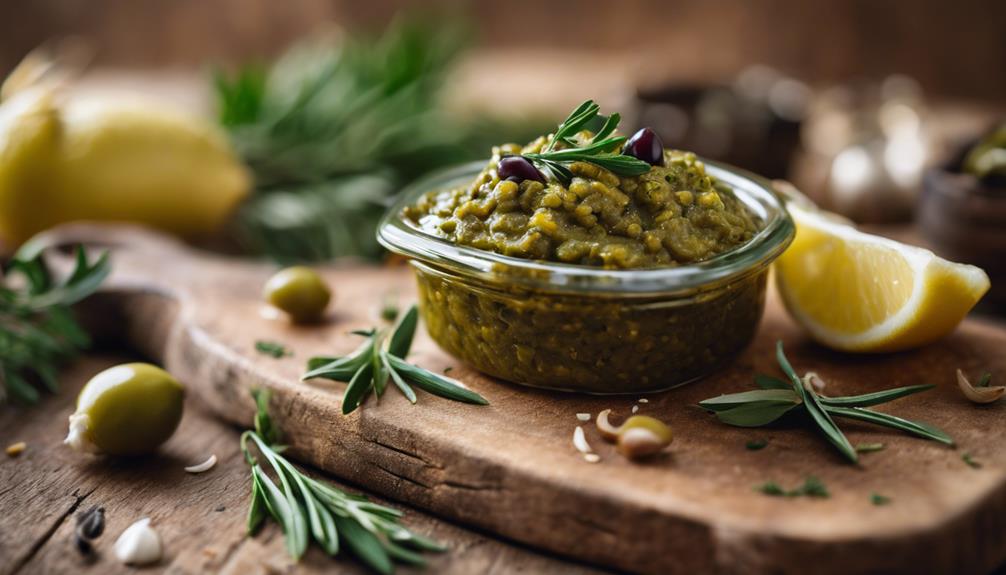
To create a flavorful and well-balanced green olive tapenade, start by selecting high-quality green olives recommended by expert chefs. These olives serve as the foundation of your tapenade, so it's important to choose ones that are briny and full of flavor.
Here are some expert recommendations for crafting the perfect green olive tapenade:
- Fresh Herbs: Enhance the overall taste of your tapenade by incorporating fresh herbs like parsley and basil. These herbs add a layer of freshness and complexity to the spread.
- Capers: Introduce a salty and sharp contrast to the buttery green olives by mixing in capers. These small, pickled flower buds provide a burst of flavor that complements the olives beautifully.
- Lemon: Add a bright and citrusy element to your tapenade with lemon juice and zest. The acidity of the lemon helps balance the richness of the olives and olive oil, creating a harmonious blend of flavors.
More Recipe Inspiration
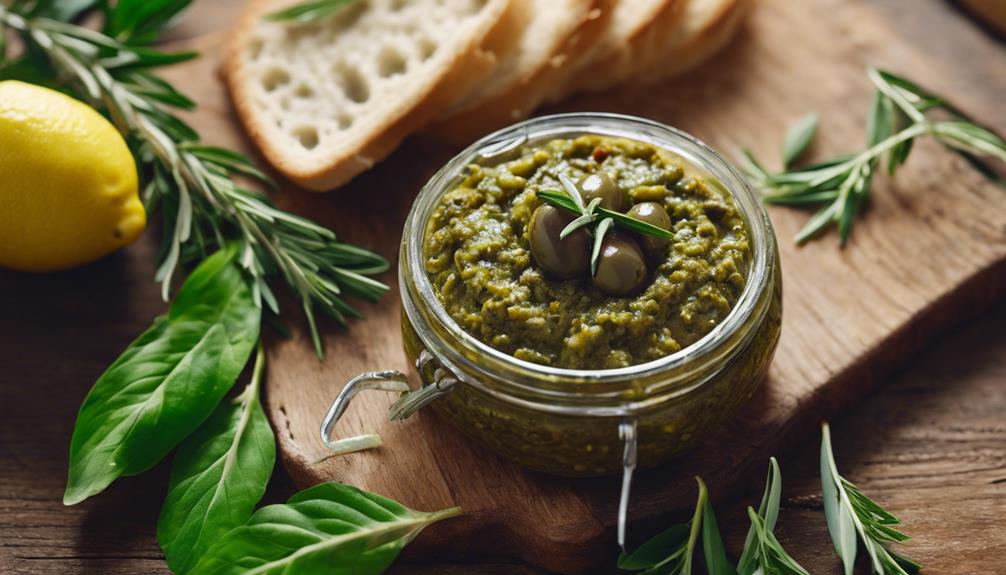
Consider exploring different variations of green olive tapenade to discover new and exciting flavor combinations for your culinary creations. By incorporating ingredients like black pepper for a hint of spiciness, lemon juice and zest for a citrusy kick, and using a food processor for a smooth consistency, you can elevate the classic green olive tapenade to new heights.
Experiment with the ratios of olives to peppers and adjust the level of lemon zest to suit your taste preferences.
When using green olive tapenade as a spread, try it on sandwiches, wraps, or burgers for a burst of tangy flavor. For a more substantial meal, pair it with grilled vegetables or roasted meats, or use it as a topping for bruschetta.
Consider adding a dollop of tapenade to your pasta dishes or salads to infuse them with a zesty and salty essence. Additionally, explore using green olive tapenade as a marinade or finishing sauce to enhance the taste of grilled fish, seafood, or chicken. Its versatility makes it a delightful accompaniment to charcuterie boards, bringing a Mediterranean flair to your spread.
Frequently Asked Questions
What Is Olive Tapenade Made Of?
Olive tapenade is made of olives, capers, olive oil, garlic, and anchovy paste. These ingredients are finely chopped or blended to create a spreadable consistency. You can customize it with herbs, lemon, and seasonings to suit your taste.
What Is a Tapenade Spread?
Imagine a culinary symphony on your palate – tapenade, a harmonious blend of olives, capers, garlic, and herbs. This savory spread, with its briny and tangy notes, elevates any dish, adding depth and flavor.
What to Do With Green Olive Tapenade?
Looking for ideas? Spread green olive tapenade on sandwiches, top grilled veggies, mix into pasta, or add to homemade pizzas. Try it on toasted baguette slices for a quick snack. Get creative with this tangy spread!
Is Olive Tapenade the Same as Pesto?
No, olive tapenade isn't like pesto. Tapenade blends olives, capers, and anchovies for a briny spread, while pesto mixes basil, pine nuts, Parmesan, and garlic for a fresh sauce. Each adds distinct flavors to dishes.
Can Green Olive Tapenade Be Used as a Topping for Potato Latkes?
Yes, green olive tapenade can be used as a tasty topping for potato latkes with smoked salmon. The salty and briny flavor of the tapenade complements the savory potato latkes and adds a burst of flavor to each bite. Try it for a unique twist on a classic dish.
Conclusion
To wrap up, green olive tapenade is a versatile and flavorful spread that can elevate any dish. With its tangy and savory taste, it adds a unique touch to appetizers, sandwiches, and more.
Whether you stick to the classic recipe or experiment with different flavor variations, this spread is sure to impress your guests. So next time you're looking for a delicious and easy-to-make condiment, consider whipping up a batch of green olive tapenade. Your taste buds will thank you.
